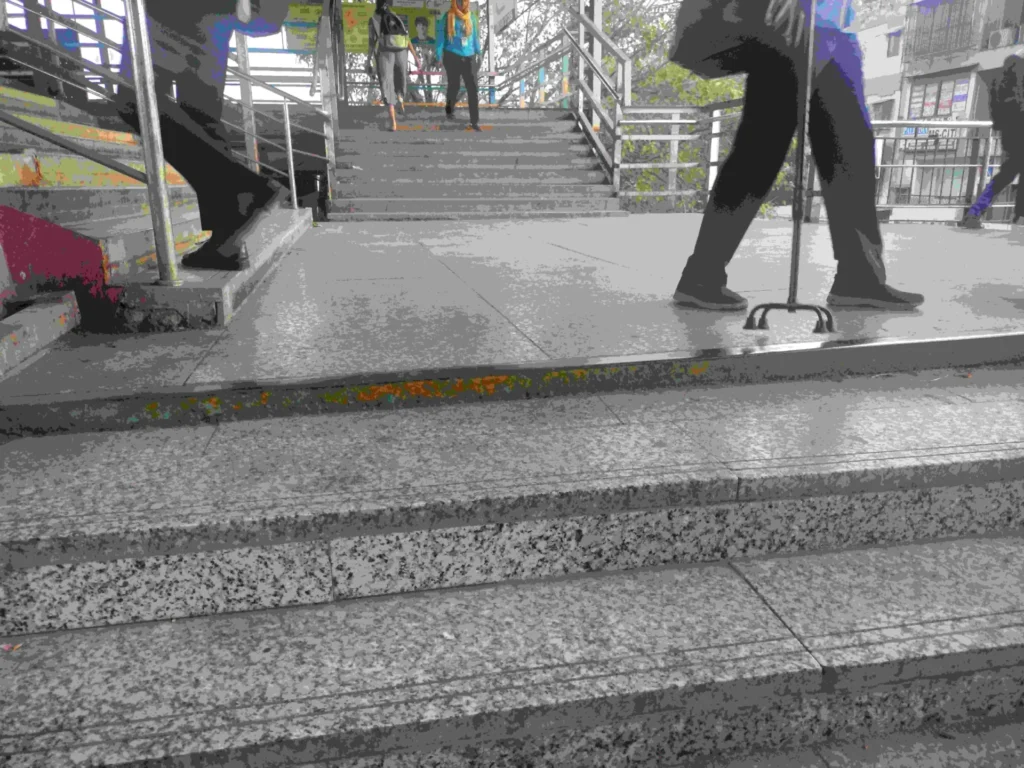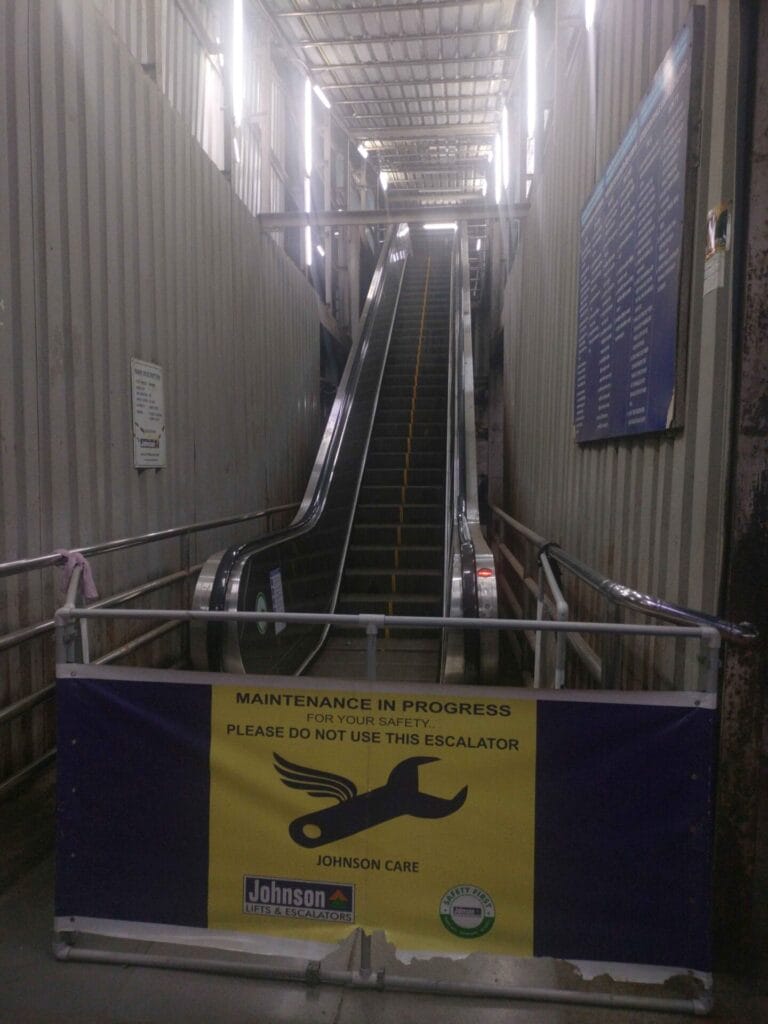Fransisca Dantas, a visually challenged teacher, has a unique accessibility challenge while boarding the Mumbai local trains. She travels five days of the week from Andheri to Dadar by the local train for work. At Andheri, announcements about the arrival of trains, whether they are 12 or 15 coach, are erratic. This means passengers don’t know where the women’s compartment will be. Like other women commuters, she cannot run to get into the women’s compartment once the train arrives. “If it is a 15 coach, people start running helter skelter. With a first class season ticket I can get into the general first class. I can’t get into the general second class in the morning peak hours.” She now has a first class season ticket, which is much more expensive than the second class one.
What may seem like a minor inconvenience to an able-bodied person, could potentially be dangerous for someone like Fransisca, who has been medically certified as being 100% blind. There are many disabled passengers among the over 7.5 million daily commuters who use the Mumbai Suburban Railway everyday.
The railway authorities have been taking measures to improve accessibility for disabled passengers, but lived experiences of passengers indicate that implementation could be a lot better.
Read more: Inaccessible public transport: Small changes can go a long way for differently-abled
Measures taken by railways to improve accessibility
The first train of the Mumbai Suburban Railway ran from Bori Bunder (today called Chhatrapati Shivaji Maharaj Terminus) to Thane in 1853. In 1867 a train service was started between Virar and Back Bay.
“In a system like Mumbai local, accessibility is a retro-fitted thing. It is not conceived right from its inception,” points out Tony Kurian, who is visually challenged. Fransisca points out that Dadar station has escalators on all platforms except platform number four, which has no place to build one.
According to the CPRO of Western Railways (WR), Sumit Thakur, there are 176 lifts and 173 escalators across WR platforms including 54 lifts and 106 escalators over the Mumbai suburban section.
Tony lists the steps taken by the railway to make trains disabled-friendly, “Yes, it has definitely done a lot. Not only there are escalators, there are specific auditory signals for visually impaired folk to identify where the compartment for the disabled would come.”
He also says that the tactile tiles on platforms were helpful to him, when he travelled from Govandi.
Read more: Inaccessible public transport: Difficult and expensive travel for differently-abled
How effective are these measures?
The obvious question when it comes to accessibility is whether these actions are enough.
Undoubtedly, the railway infrastructure is under extreme pressure given the population of the city, and the number of people who make use of the three rail lines each day. Figures calculated on the basis of average number of passengers and sale of tickets, in the financial year 2023 show that 26.57 lakh passengers used WR and 35.38 lakh travelled by Central Railway (CR).
The same logistical issues plague the compartment reserved for the disabled as the others.
Siddharth Mhatre, who has cerebral palsy and makes use of a wheelchair wonders how effective the reserved coach is to improve accessibility since the train does not stop long enough for people with mobility issues to get in, especially given the crowd. He says, “What is the use of the compartment? After all, the train is never going to wait for people like us. To climb in the train is very, very difficult unless you start at the starting point and end at the ending point.”
Moreover, they are also reserved for people suffering from cancer, and women in advanced stages of pregnancy, thus adding to the number of people getting in.
Advocate Jaydeep Tanna, regularly tweets about how able-bodied, unauthorised commuters enter the coach reserved for differently abled persons. He has experienced that the Railway Protection Force (RPF) does not always act upon the complaints made against unauthorised commuters encroaching into the reserved compartment. It sends a message that the miscreants can repeatedly get away with it.
Moreover, senior citizens also end up in this coach despite being given fourteen seats in the general compartment because they just cannot get in during the peak hours. It is equally true that sometimes a disability is not conspicuous or visible. When such a passenger enters into the reserved coach or a lift meant for the disabled, the other commuters insist that they get out. Fransisca does not use the reserved coach for this very reason.
The story is the same where lifts are concerned. Despite a board declaring that they are meant for the disabled and senior citizens, everyone wants to make use of them.
Activist Samir Zaveri, who uses artificial legs, narrated the case of Borivali station, which is a halt for outstation trains. People find it difficult to go across the foot over bridge (FOB) with heavy luggage, so they end up using the lift. In fact, Samir empathises with them, but believes that they should give priority to the people for whom it is reserved.
The disparity in the number of lifts and escalators also irks people with disabilities Fransisca questions why there are three escalators at Andheri west and not a single one in the east. So, she uses the metro escalator to reach the train platform, which takes longer time.
Read more: How do persons with disability feel about public transport in Mumbai?
Railways can take small but significant measures
There are limitations to how many infrastructural changes can be made to make railways disabled friendly given its ancient provenance. But there are certain easy measures that they can be mindful about and will help significantly.
For instance a new FOB at Andheri has even uneven sized steps making it difficult for a visually impaired person to gauge where to step. Platforms have potholes making it dangerous. FOBs should also have ramps for the wheel-chair bound.
While the beeping sound, which signifies where the reserved compartment will come on the platform is very useful for the visually impaired, at times the beeping from more than platform can be heard simultaneously confusing them.
Even more importantly, the signage for the first class coach or the women’s compartment are not repainted regularly. Or if the boards are clear, they do not specify whether it is for the 15 or the 12 coach. All this considerably lowers accessibility for people with disabilities.
Chapter 8, section 41(c) of the The Rights of Persons With Disabilities Act, 2016 (RPwD) states that the appropriate government will take measures to provide accessible roads to address mobility necessary for persons with disabilities.
Samir says that this includes parking spaces for the disabled. This facility has been provided where a station is a terminus, but not at all stations. He also gives the example of Borivali station where platforms 1, 2 and 3 are in one continuous line. In this case it makes it difficult for him to walk if he has parked in the reserved parking space and he has to walk all the way to platform number 3.
Siddharth prefers travelling by flight when going out of Mumbai for the same reasons. One may have to log quite a long distance from the entrance of the platform to the escalator, unlike at the airport where a wheelchair is available from the entrance itself.
In addition, he says the porters are rude at railway stations and have not been sensitised. All this does not align with his goal of being able to travel independently, thus prompting him to choose air travel despite it being more expensive.
Immediate action and long term vision
No doubt that the railway is working towards aligning itself with the persons with disabilities but it has its limitations.
“All the new projects for station redevelopment under the Amrit Bharat Station Scheme are planned to cover every mandatory aspect for Senior Citizens & Divyang policy as per prescribed timelines of the policy as per category of the station,” assures the CPRO of WR.
On the other hand, they are being negligent about things, which can easily be done despite these limitations. A stronger will, and empathetic implementation is required to make the railways truly disabled-friendly.
Call to action
| What can railway authorities do to improve accessibility? |
| * While building FOBs ensure that the steps are even-sized * Repaint boards indicating position of the coaches on the platform regularly, so that they are clearly visible * Put clear signage indicating positions of women’s and first class compartments for both 12 coach and 15 coach trains * Announce before the arrival of the train if it is a 15 coach or a 12 coach train * Ensure that reserved parking space is available for the disabled near the entry and exit points at every station * Make wheelchairs easily available at stations * Sensitise staff about issues of people with disabilities so that they are empathetic and respectful |


